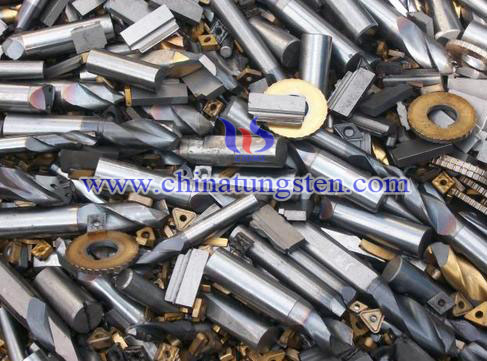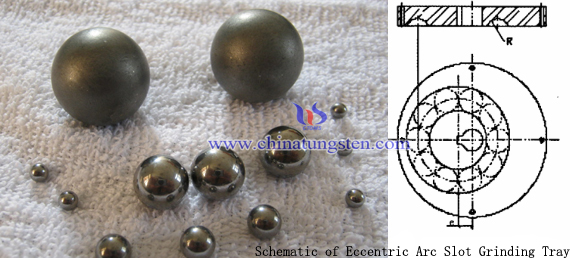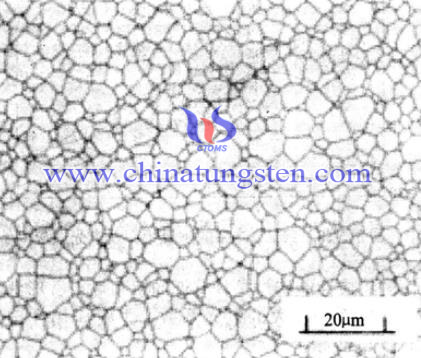Ammonium Paratungstate Used for Preparing Tungsten Carbide Wear-Resistant Coating
- Details
- Category: Tungsten Information
- Published on Tuesday, 02 February 2016 17:24
- Written by chunyan
- Hits: 251
 Wear-resistant coating is a kind of new functional coating with special function, such as good abrasion resistance. Tungsten carbide (WC), the kind of important hard alloy material, is a black six square crystal with metallic luster, which the hardness is similar to diamond. Because the properties tungsten has, it is increasingly becoming an important strategic significance material. A method for preparing tungsten carbide wear-resistant coating from ammonium paratungstate (APT) is presented in this paper.
Wear-resistant coating is a kind of new functional coating with special function, such as good abrasion resistance. Tungsten carbide (WC), the kind of important hard alloy material, is a black six square crystal with metallic luster, which the hardness is similar to diamond. Because the properties tungsten has, it is increasingly becoming an important strategic significance material. A method for preparing tungsten carbide wear-resistant coating from ammonium paratungstate (APT) is presented in this paper.
Specific steps:
1. Calcining ammonium paratungstate to prepare tungsten oxide powder, control the temperature at 650~750℃;
2. Place the tungsten oxide powder in the reaction vessel, and adding one of alcohol, acetic acid and acetone, or the mixture of them, filter and get the light yellow tungsten oxide sol;
3. Heated and stirred to evaporate, and then the tungsten oxide gel was prepared;
4. Soaking hard alloy in he tungsten oxide gel, filming by dip-coating method, keeping the speed at 50~200mm/min;
5. Hard alloy coated with tungsten oxide nano film was prepared by drying and cooling;
6. Carbonization the hard alloy plated with tungsten oxide nano film in the reduction furnace full of reducing gas, which is carbide mixture gas of H2 and C2H2, temperature controlled at 950~1200℃ for 3~5 hours, then get the hard alloy plated with tungsten carbide wear-resistant coating.
| APT Supplier: Chinatungsten Online ammonium-paratungstate.com | Tel.: 86 592 5129696; Fax: 86 592 5129797;Email:sales@chinatungsten.com |
| Tungsten News&Tungsten Prices, 3G Version: http://3g.chinatungsten.com | Molybdenum News & Molybdenum Price: http://news.molybdenum.com.cn |
Ammonium Paratungstate Prepared from Tungsten Scraps
- Details
- Category: Tungsten Information
- Published on Tuesday, 02 February 2016 17:21
- Written by chunyan
- Hits: 258
With tungsten massive mining and use level increasing, tungsten resources will be less and less, and the world tungsten industry will face a severe situation. Reasonable recovery of tungsten scraps can make up for the shortage of tungsten resources, which brings huge economic benefits. A method which will bring good economic benefit and promote the tungsten scraps recycling by the time preparing ammonium paratungstate (APT).

The specific preparation steps are:
1. Electric solution and magnetic separation: tungsten scraps separated in electrolyte solution to obtain tungsten carbide pellets, and then separator;
2. Decarburization: tungsten carbide set in the furnace for decarburization reaction to get tungsten oxide, control the temperature in 500~1600℃, keep the air circulation or inlet 0.5 ~ 1.0atm oxygen;
3. Dissolved in alkali solution: add tungsten oxide into NaOH solution which the mass concentration is 30%~50%, control the temperature at 130~180℃, stirred and soaked to obtain crude sodium tungstate;
4. Impurities removal: filter the sediment to remove bivalent ions of cobalt, nickel, iron and manganese, and also other impurities.
5. Dissolved in ammonia solution, and then crystallize: adding and stirring ammonia into tungsten organic phase, and then crystallize to obtain high purity ammonium paratungstate.
| APT Supplier: Chinatungsten Online ammonium-paratungstate.com | Tel.: 86 592 5129696; Fax: 86 592 5129797;Email:sales@chinatungsten.com |
| Tungsten News&Tungsten Prices, 3G Version: http://3g.chinatungsten.com | Molybdenum News & Molybdenum Price: http://news.molybdenum.com.cn |
Tungsten Carbide Ball Eccentric Arc Slot Grinding (1/2)
- Details
- Category: Tungsten Information
- Published on Tuesday, 02 February 2016 17:10
- Written by xiaobin
- Hits: 237
Compared with tungsten carbide ball V-slot grinding process, the rotating center of eccentric arc slot is deviated from the overall center. And the linear velocity of contacting points between tungsten carbide ball and grinding tray, it also adds a new rotary motion, which makes spin angle convert from relative invariant into the space amount, and the space included angle of axis of revolution become larger. The schematic of eccentric arc slot grinding tray is given as follow:

We can see from the figure, the eccentric circular groove grinding its way movement can be broken down into simply V-groove movement along the X axis and pure rolling. By adjusting the rotational speed, changing the relative velocity of the polishing, and it can achieve a wide range of spin angular variation, and to satisfy the carbide ball into round basic conditions that is 1. Equal probability: each dot on each of them to be processed carbide surface of the ball has the same probability of cutting; 2. Alternatives of grinding: in the process of grinding, the ball with large size should be ground more and the small size ground less or not; the margin of the longitudinal direction should be ground more and the margin of minor axis direction ground less or not.
| Tungsten Carbide Supplier: Chinatungsten Online tungsten-carbide.com.cn | Tel.: 86 592 5129696; Fax: 86 592 5129797;Email:sales@chinatungsten.com |
| Tungsten News&Tungsten Prices, 3G Version: http://3g.chinatungsten.com | Molybdenum News & Molybdenum Price: http://news.molybdenum.com.cn |
Tungsten Carbide Ball Eccentric Arc Slot Grinding (2/2)
- Details
- Category: Tungsten Information
- Published on Tuesday, 02 February 2016 17:13
- Written by xiaobin
- Hits: 233
Before the grinding, according to the specifications of tungsten carbide ball to be ground, using the tool for forming the eccentric circular groove finishing, precision controlled within ± 0.01, which effectively ensure the good agreement between the ball and the grinding groove. Overall, the process can be divided into coarse grinding balls, semi-fine grinding, grinding, coarsely ground, semi-lapping, lapping, fine grind, polish eight processes. Before the beginning of each process must be thoroughly clean the device and select the appropriate size of the grinding tray. Generally, grinding compound is oil based boron carbide (BC), the granularity is about 180#, which effectively ensure the precision and efficiency of tungsten carbide ball, the sphericity is better than 0.6μm, the average rate of grinding can reach 20 μm/h.
In addition, after grinding to measure tungsten carbide ball, which the precision is related to the methods of measurement, the choice of measuring apparatus, the quality of ball surface, the fineness or cleanliness of ball surface, humiture of the conditions and many factors. After coarsely ground and semi-lapping should be used to measure microscopic micrometer, and take at least 20 points in the space above the whole sphere, ball measurement accuracy can be controlled within the 2μm. It should be used after lapping and polishing processes high-precision roundness measurement, measurement accuracy (0.04 + 6H / 1000μm, H refers to measuring height). Each batch of carbide spheres need to be tested with alcohol wipe, and left more than 4 hours in a constant temperature environment 25 ℃, the temperature and the sphere to be measured ambient temperature measurements can be carried out after leveling. Three cross-sectional scans every single space sphere has mutually perpendicular, each circular cross-section values are less than 1μm, sphericity this sphere can be considered qualified, sphericity value should be the average of measurements taken.
| Tungsten Carbide Supplier: Chinatungsten Online tungsten-carbide.com.cn | Tel.: 86 592 5129696; Fax: 86 592 5129797;Email:sales@chinatungsten.com |
| Tungsten News&Tungsten Prices, 3G Version: http://3g.chinatungsten.com | Molybdenum News & Molybdenum Price: http://news.molybdenum.com.cn |
Inquiring Tungsten Trioxide Ceramic Sintering Phase
- Details
- Category: Tungsten Information
- Published on Tuesday, 02 February 2016 16:43
- Written by qiongyao
- Hits: 228
 The study shows that the tungsten trioxide ceramics we prepared sintering at 1180 ℃, the relative density can reach about 94%. This means that the solid-phase sintering of both the early and mid-stage of our design before sintering process conducted post-sintering generally begins with relative density of the sintered body is greater than 90% at this stage, which is mainly a small pore exclusion and isolation grain growth. Pore radius of curvature by stress shrinking, with the closed pores increase in the gas pressure to achieve balance. Closed pores of the grain boundary portion fill the internal volume of the crystal through diffusion, this process is slow, and the densification is restricted. Late sintering, pores become isolated and grain boundaries communicate with each other form network, so it is only through the discharge pore volume of the grain boundary diffusion or to achieve grain growth through grain boundary migration.
The study shows that the tungsten trioxide ceramics we prepared sintering at 1180 ℃, the relative density can reach about 94%. This means that the solid-phase sintering of both the early and mid-stage of our design before sintering process conducted post-sintering generally begins with relative density of the sintered body is greater than 90% at this stage, which is mainly a small pore exclusion and isolation grain growth. Pore radius of curvature by stress shrinking, with the closed pores increase in the gas pressure to achieve balance. Closed pores of the grain boundary portion fill the internal volume of the crystal through diffusion, this process is slow, and the densification is restricted. Late sintering, pores become isolated and grain boundaries communicate with each other form network, so it is only through the discharge pore volume of the grain boundary diffusion or to achieve grain growth through grain boundary migration.
The sintering is divided into three stages:
1: The initial stage of sintering. Embryo between powder particles in contact with each other through the mass transfer process, called sintering neck, and through their growth so that the embryo shrinkage;
2: Sintering the medium term. Grain growth begins at the beginning, and it is accompanied by a wide range of facets formed between the particles. In this case, the pores remain interconnected into continuous network, and the crystal interfaces between the particles remain isolated from one another. Most of the densification process and partially microstructure are produced in this phase;
3: Post-sintering. With the sintering process porosity becomes isolated, isolated pores eliminates the grain boundaries began at the grain boundary diffusion to form a continuous network. Post-sintering densification rate slowed down, and the development of microstructure such as grain growth is more rapid.
| Tungsten Oxide Supplier: Chinatungsten Online www.tungsten-oxide.com | Tel.: 86 592 5129696; Fax: 86 592 5129797;Email:sales@chinatungsten.com |
| Tungsten News & Prices, 3G Version: http://3g.chinatungsten.com | Molybdenum News & Molybdenum Price: http://news.molybdenum.com.cn |





 sales@chinatungsten.com
sales@chinatungsten.com